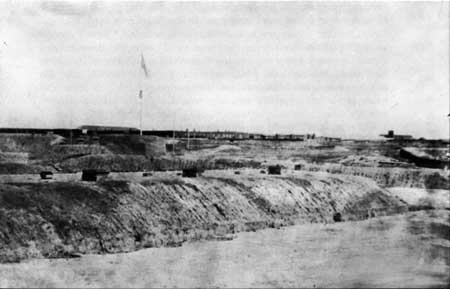|
FORT UNION National Monument |
 |

The Star Fort, about 1866.
U.S. Signal Corps Photo, National Archives.
The Star Fort
Other troops busied themselves constructing a massive earthen field work designed to block the Santa Fe Trail to Confederate advance from the south. Located in the valley east of the log fort, it began to take shape in July 1861, shortly after the fall of Fort Fillmore.
Earth parapets formed a square with angles shaped like arrowheads jutting out 200 feet from each corner. In these angles were storehouses, company barracks, and officers' quarters. Other quarters and a magazine occupied the quadrangle. The parapets supported firing platforms and artillery emplacements. Four more earthen angles projected from the sides of the square as curtains against enemy fire. In geometric design the fortification resembled an eight-pointed star, and thus became known as the star fort.
A newly arrived officer pronounced the star fort "as fine a work of its kind as I ever saw" and vowed that "all Texas can't take it." Later, another officer reached a different conclusion. Firing cannon at the fort from the top of the mesa to the west, he demonstrated that "The work has a dip toward these hills which causes its whole interior to be revealed." Not only could enemy artillery rake the interior, but guns mounted on the parapet could not reach the brow of the mesa, where attackers would logically place their cannon.
The star fort afforded no improvement in living conditions. Like the old fort, the quarters and storehouses of the new were built of unbarked pine logs that quickly rotted and housed nesting places of insects. Built partly underground, the rooms were damp, unventilated, and consequently unhealthy. In heavy rains, water seeped through the roofs and ran in the doors, turning the dirt floors to mud. The unsodded parapet began to erode, filling the surrounding ditch with soil. Rather than live in such hovels, most of the troops camped in tents outside the fortification.
Work continued intermittently on the star fort until June 1862. By then the issue in New Mexico had been decided. There was no further need for a fortification.

|
|
Last Modified: Sat, Sep 28 2002 10:00:00 pm PDT |


